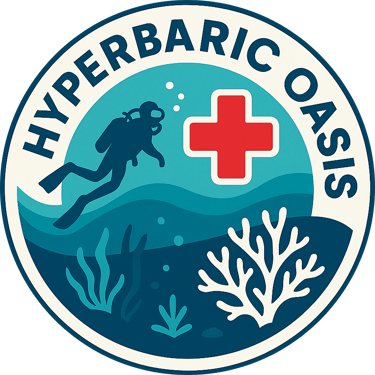Frequently Asked Questions
What is Hyperbaric Oxygen Therapy (HBOT)?
Hyperbaric Oxygen Therapy involves breathing 100% pure oxygen in a pressurized chamber. The increased pressure allows your lungs to absorb more oxygen than under normal conditions, which promotes healing and fights infection.
How many sessions are needed?
It varies. For wound care, you may need 20–40 sessions. Acute conditions may require just a few treatments.
What is HBOT used to treat?
HBOT is FDA-approved for several conditions, including:
Decompression sickness (common in divers)
Carbon monoxide poisoning
Chronic non-healing wounds (especially in diabetics)
Radiation injuries (from cancer treatment)
Severe anemia
Crush injuries or traumatic ischemias
Thermal burns
Gas gangrene
Skin grafts/flaps at risk of tissue death
Necrotizing soft tissue infections
*Off-label uses, such as for:
Autism
Stroke recovery
Lyme disease
Long COVID
Cerebral palsy
Traumatic Brain Injury (TBI)
Stroke recovery
Anoxic brain injury
Neurodegenerative diseases (Alzheimer’s, Parkinson’s)
PTSD
Fibromyalgia
Who should not undergo HBOT?
It may not be suitable for people with:
Untreated pneumothorax (collapsed lung)
Certain lung diseases (e.g., COPD with CO₂ retention)
Ear infections or eardrum damage
Pregnancy (for some conditions, consult your doctor)
How long does a typical HBOT session last?
Usually 60 to 120 minutes, depending on the condition being treated. Treatment may be done daily over several weeks.
How does HBOT help the body?
Increases oxygen in the blood and tissues
Promotes new blood vessel growth
Enhances white blood cell activity to fight infection
Reduces inflammation and swelling
Helps detoxify carbon monoxide and other gases
Supports tissue regeneration
What does it feel like inside?
You may feel pressure in your ears, similar to airplane takeoff/landing. The chamber is quiet, and you can usually sleep, read, or watch TV.
How should I prepare for my HBOT session?
Avoid alcohol, caffeine, and carbonated drinks
Eat a light meal 1–2 hours before treatment
Remove jewelry, make-up, lotions, oils, and flammable fluids
Let the staff know if you have a cold, congestion, or ear problems
Get a medical evaluation
Are Soft or Hard chambers the same ?
No soft chambers reach 1.3 ATA and is only used to treat acute altitude sickness, Our Hard Chamber gets up to 2 ATA with more potential health benefits

